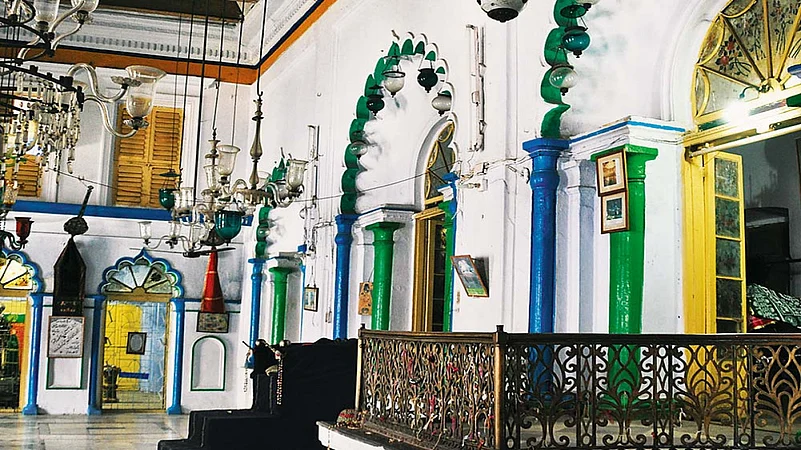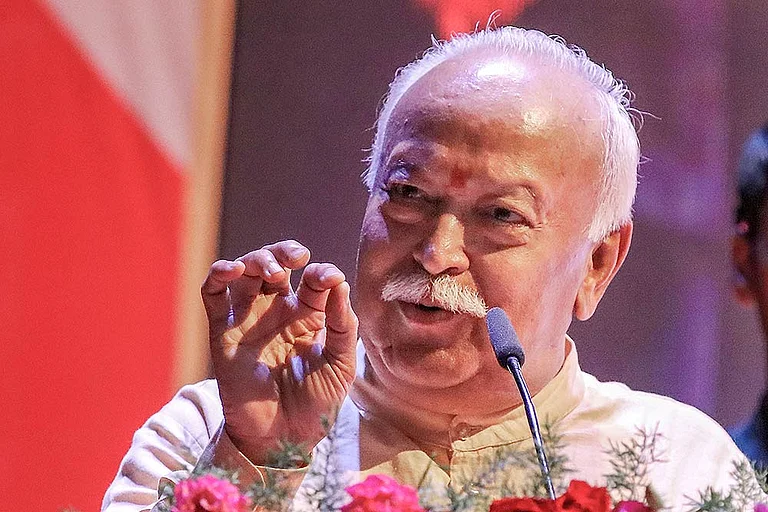We humans are the children of chance and circumstance, and the civilisations and cultures we straddle, and the connections between them, are woven through the quirks of fate. Chance, too, directed the connection between the city of Nishapur in the province of Khorasan in Northeastern Iran, known for its high-quality turquoise, and Calcutta. The first Nawab of Awadh, Sadaat Khan Burhan-ul-Mulk, was a Persian noble from Khorasan who came to India in 1708. The last was Wajid Ali Shah, who spent the last 31 years of his life in Calcutta.
Born on July 30, 1822, Wajid Ali Shah was not in the direct line of succession and received no special treatment during his early years. As Nasiruddin Haider died heirless, his grandfather’s brother, the 63-year-old Nawab Mohammad Ali Shah, was crowned the third king of Awadh. His son Amjad Ali Shah took over after four years. When he died of cancer, the young Wajid Ali Shah was crowned in 1847.
Wajid Ali Shah’s rule coincided with the East India Company’s decision to swallow whole the rich kingdom of Awadh. Contrary to popular perception, Shah took a keen interest in administration. He would mount a horse and supervise the infantry in the early mornings at Musa Bagh. He introduced reforms and strengthened the existing judicial system on the principles of Mohammedan and Hindu laws. The king transferred land revenue management to a set of trained officials, instead of clinging on to autocratic power. All these were abhorred by Company officials.
The British interference in Awadh started after the Battle of Buxar in 1764, when nawab of Awadh Shuja-ud-Daulah and his temporary allies, Mir Qasim, nawab of Bengal and Mughal Emperor Shah Alam II, took on the Company’s army. After their defeat, Company troops were stationed in Awadh at the nawab’s expense. Within a few years, a British Resident was also installed. Finally, under Governor-General Dalhousie, Awadh was annexed on February 7, 1856 on a false charge of maladmistration. Wajid Ali Shah’s helpless, baffled pain at being wrongfully deprived of his beloved kingdom is portrayed convincingly in Satyajit Ray’s Shatranj Ke Khiladi (1979).
It was a hot, humid day on May 13, 1856, when Shah stepped out of the steamer McLeod as it anchored at Metiaburj, Calcutta, with his mother Malikah Kishwar, son and heir-apparent, Prince Hamid Ali, younger brother Sikandar Hashmat and about 500 people of his entourage. From Lucknow, he had stopped at Kanpur, Allahabad and Varanasi. It took him 18 days to reach Calcutta after the Maharaja of Varanasi, Ishwari Prasad Narayan Singh, offered a reverential salutation. He had no idea that he would spend the next 31 years of his life in this culturally rich city, that Awadh would remain a distant dream.
Canning had replaced Dalhousie by that time and interestingly, accorded a 21-gun salute to Shah from the ramparts of Fort William. The deposed ruler soon realised that the shrewd governor-general was appointed to promote only the company’s interests. Despite this initial setback, he sent his mother, brother and son to England to place his case before Queen Victoria and British Parliament.

A photo of Wajid Ali Shah in Calcutta
While negotiations were going on in England, the great uprising of 1857 broke out and all hopes of Awadh being restored to its deposed ruler were dashed. Even after annexation, Shah was universally loved. Fearing that the ‘mutineers’ could rally around Wajid Ali Shah and start a rebellion in Calcutta, Canning, with due courtesy, put the deposed king under house arrest in 1857 at Amherst House inside Fort William, where he spent 26 months. After his release, he decided to live in Calcutta and chose Metiaburj, by the Hooghly, as it had a three-km stretch of opulent houses, acres of gardens, lush vegetation, panoramic view of the trees of the Botanical Garden and the cool river breeze. The Hooghly reminded Shah of Lucknow’s Gomti and was a salve to his broken heart.
When news spread that Shah had decided to recreate Lucknow’s opulent magic in this new suburb, hundreds of loyal subjects joined him. Seeing this, the astute, and paranoid, British tried to defame him variously. But the artistic, talented Shah—a reputed poet, great composer of thumris and a generous patron of the arts—successfully laid the foundation of a refined culture, signs of which are strewn across this great metropolis. Metiaburj developed as a city within a city, morphing in the process into a mini-Lucknow, soaked in the exquisite, elaborate ways of royalty and nobility.
The formal entry of Urdu in Calcutta began with the establishment of the Calcutta Madarsa in 1781 by Warren Hastings. In 1784 William Jones established the Asiatic Society, which helped in the advancement of many languages, including Urdu. However, Urdu flourished when thousands of Awadhis flocked to Metiaburj. The settlers spoke chaste Urdu and it spread its distinction and sweetness among the masses. Shah continued to patronise the language by encouraging writers and poets through popular events like mushairas (poetic symposiums), ghazals, marsiaya (the tragedy of Karbala recited in the lyrical form), and qawalis. As a result, it gave rise to a new generation of talented poets, writers, singers, and narrators. Even now, traditional families in Metiaburj still use expressions and metaphors that are redolent of a lost age of nobility and have gone out of daily usage. Interacting with them, one is transported to a bygone era. A major literary figure, Shah was a master of Persian and Urdu literature and wrote about 100 books, many of them published in his private press—Matbua-i-Sultani, or royal press.
Awadh’s cultural loss added glory to Calcutta’s 19th century cultural efflorescence. In regal style, the king held Kathak programmes in his parikhana, the abode of his young dancers. Talented artistes like Raja Sourindra Mohan Tagore of the Pathuriaghata Tagore family and Pandit Jadu Bhatta were among those who benefited from an atmosphere steeped in music. With royal patronage based out of Calcutta, accomplished singers, instrumentalists, lyricists and dancers all converged there from Lucknow, Varanasi, Allahabad, Kanpur and other places.

The nawab as played by Amjad Khan in Shatranj Ke Khiladi
It was all a revelation for the rich zamindars and babus of Bengal and they, too, built their jalsaghars (dancing halls) where programmes of Thumri or Kathak were regularly held. As rich Bengalis started patronising artistes, it led to the growth of hundreds of kothas, or salons of fine arts, of baijis across the city. It was thus that Calcutta emerged as the new cultural capital, attracting artistes and patrons from all over India.
The song Babul Mora Naihar Chuto Hi Jai, attributed to Shah, remains the most popular bhairavi in the state—a testament to his musical genius. This song was popularised by city-based music director Rai Chand Boral when he got K.L. Saigal to sing it for the movie Street Singer (1938). In later years, as the Hindi film industry blossomed and attracted talent from all parts of undivided India, artistes from Bengal played an important role as dance and music became an integral part of films.
Kite flying was an extremely popular pastime in Awadh and Shah introduced it in Calcutta. Like many new ideas, it soon caught on with the rajas, maharajas and zamindars of the 19th-century Bengal, becoming a favourite pastime. Soon it evolved into a mass sport--regular competitions, with high prize money, were held and this gave rise to a huge demand for kites and manjha (sharpened thread), resulting in numerous shops mushrooming all over the city. There are still many units active in Metiaburj that produce thousands of kites that are supplied all across India. Intriguingly, most workers are women operating from their houses. The strenuous work does not fetch much, but supports 3,000 families in an economically backward area.
During Shah’s stay in Calcutta, other pastimes like cock-fighting and flying pigeon (kabootar baazi) also became extremely popular. A lot of time, money and energy were spent on rearing and training pigeons. Some bright sparks cross-bred pigeons to produce champions that fetched high prices. The sport still has its votaries amongst many men.
For generations, rulers and nobilities of Awadh had struck a fine figure in their fine silks and fashionable and expensive raiments. It was little surprise that Wajid Ali Shah brought with him to Metiaburj the fine art of Lucknawi tailoring. To cater to the demand, tailors from Awadh settled close to Metiaburj. They excelled in stitching achkhan, sherwani, churidar, kurta-pyjama, shahrara, gharara, and shalwar-kameez. Skils were passed on through generations; giving birth to a huge community of tailors. Hundreds of shops selling cloths and other accessories came up to support this trade. Calcutta and its environs is now one of the biggest manufacturing centres for unbranded garments in Asia, supplying garments to expensive and renowned boutiques across the country, beside to the export market. It accounts for Rs 15,000 crore worth of textile trade annually.

The way to Nawab Wajid Ali Shah’s mausoleum in Sibtainabad Imambara, Metiaburj, Calcutta
One of the glories of Awadhi culture is its world-famous cuisine, and Wajid Ali Shah’s stay in Calcutta resulted in a gastronomic revolution. If there is one thing Bengal remembers Shah for, it is for the delectable Awadhi cuisine in general and biryani in particular. How this magical dish from Lucknow came to Calcutta and evolved into the Calcutta biryani with its signature potato is an oft-told story. Some of the talented chefs or khansamas accompanied Shah from Lucknow, bringing with them the secrets of pulao, korma, kebab, biryani, zarda, roghni roti, sheermal, shahi tukra….. These chefs introduced the traditional Awadhi style of cooking—Dum Pukht—in Calcutta.
According to 86-year-old Sahebzada Wasif Mirza, president of the Awadh Royal Family Association and patriarch of the family, Wajid Ali Shah is more popular and loved in Calcutta than in Lucknow. Even 134 years after Shah’s death, his name is taken with reverence, pride and affection in Bengal. Poignantly and significantly, this great cultural figure was celebrated on film not by directors, past and present, of Urdu and Hindi films, but by the city’s own legend, the great Satyajit Ray. Mirza sees it as Ray’s homage to Shah. When the family approached the Calcutta Municipal Corporation to rename the main arterial road in Metiaburj after Wajid Ali Shah, it was done enthusiastically, accompanied by a glittering ceremony.
Calcutta gave refuge to an unlucky ruler and in return got to be the keeper of one of our finest cultures. Even after so many decades, ‘Lucknavi tehzeeb’ is alive in many a household. Metiaburj well deserves its old moniker—‘Chhota Lucknow’.
(This appeared in the print edition as "Bricks Of Lucknow Nagri")
Shahanshah Mirza, the great great grandson of Wajid Ali Shah, is a senior officer in the GST department, Ministry of Finance, in Calcutta





















